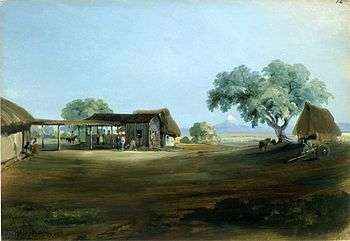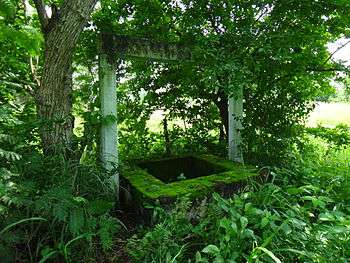Manga de Clavo

Manga de Clavo was one of the most famous properties and favorite hacienda of Antonio López de Santa Anna, a historic site from the first half of the nineteenth century where he lived and made decisions that defined Mexican politics of its time, serving practically as presidential residence and government house until it was burned and partially destroyed by the invading United States Army during the Mexican–American War in 1847-1848 without ever again being restored.
Impossible to think of Santa Anna without thinking Manga de Clavo.[1]
History
Santa Anna bought the hacienda of Manga de Clavo in 1825 with the dowry of his first wife, Inés García, the daughter of wealthy Spanish parents in Verarcuz state.[2][3] He enlarged it in size and beauty during the years in which his influence grew while holding various positions, in addition to the presidency of the Republic in six occasions, that allowed the growth of his estate. The economic production of Santa Anna's properties which included multiple villages dedicated to livestock, served the entire area between Veracruz and Jalapa. The citadel acted as a privileged strategic location relative not only to its geographical surroundings but also of military, political and commercial importance.
For Santa Anna this was a place of rest, pleasure and entertainment, suitable for intrigue and conspiracy, as well as refuge in adversity and defeat. Countless times he took the road to Manga de Clavo from the capital, slipping the responsibility of governing, abandoning presidential power only to return to the tranquility of his domain.
Precisely on the grounds of Manga de Clavo was where Santa Anna's left leg was buried, which he lost after being wounded on the dock of the port of Veracruz on December 5, 1838, during the First French intervention in Mexico, remaining in this site before it was transferred to the cemetery of Santa Paula in Mexico City.
Amongst the most important foreigners who visited Manga de Clavo is the Marquise Calderón de la Barca, wife of Angel Calderon de la Barca, minister plenipotentiary of Spain in Mexico from 1839 to 1842. In her book Life in Mexico, Calderón gives an account of the journey made from Veracruz to Manga de Clavo and the reception she had from Santa Anna and his family, this being one of the few examples and most famous description that exist of the estate:
We arrived about five at Manga de Clavo, after passing through leagues of natural garden, the property of Santa Anna. The house is pretty, slight-looking, and kept in nice order. We were received by an aide-de-camp in uniform, and by several officers, and conducted to a large, cool, agreeable apartment, with little furniture [...] In a little while entered General Santa Anna himself; a gentlemanly, good-looking, quietly-dressed, rather melancholy-looking person, with one leg [...] He has a sallow complexion, fine dark eyes, soft and penetrating, and an interesting expression of face. We then proceeded to look at the out-houses and offices; There are no gardens, but, as he observed, the whole country, which for twelve leagues square belongs to him, is a garden.[4]
Santa Anna was frequently absent from Manga de Clavo, and his first wife Inés managed the property. Although Santa Anna served as president necessitating his presence in Mexico City, Inés did not join him in the capital, preferring to live in Veracruz at Manga de Clavo. His second wife, Dolores Tosta, was from a wealthy Mexico City family, and she preferred living in the capital, leaving the management of Manga de Clavo to Santa Anna's sons-in-law married to daughters from his first marriage.[5]
Subsequently, the Plan of Ayutla revolutionary movement forced Santa Anna's government final fall and definitive exile in 1855, some of his properties were confiscated, most of the land was sold and soon Manga de Clavo was lost to landscape and memory.
There are indications that prove the survival of the hacienda set in the last decade of the nineteenth century before the Mexican Revolution, although later agricultural policies ceased large estates and extensive lands that were divided and reduced in many cases only to its main enclosure or manor house.

Photo: Hugo Fernández de Castro, July 2014
Location
The site where the estate of Manga de Clavo currently stands is located in the town of Vargas, 19 miles from the port of Veracruz in the municipality and state of the same name. Only a few foundations, scattered stones and a well survive.
Ruins that Roberto Williams Garcia, academic and researcher of Veracruz cultural environment was able to visit in 1967:
I asked for Manga de Clavo and was pointed to a couple of hundred meters from the railway, adjacent to wooden shacks within a low-rise thin brush [...] Nearby is "The Well of Santa Anna" without curbstone and sixty eight feet deep, with some sort of door half way down –which I was informed- lead to a passage, a tunnel...[6]
In the early twentieth century, the remains of Manga de Clavo gave birth to the town of Vargas which grew irregularly around the hacienda, appropriating stone and obliterating signs of its true trace, thus the mansion and adjacent outbuildings were gradually destroyed to the point that only ruins could be found at ground level, virtually ceasing to exist.
This circumstance has led to false information that is disseminated about the original and exact location of the property, all together in history books and archives, web pages and social networks, as well as in intellectual circles and by enthusiastic chroniclers of the subject-matter and local townspeople in the region, being confused with other properties, mainly Paso de Varas in the municipality of Puente Nacional and very close to the historic Puente Nacional bridge and El Lencero hacienda in the outskirts of Jalapa, both of which Santa Anna was also owner and are still clearly visible on the Veracruz countryside today.
References
- ↑ Rafael F. Muñoz, Santa Anna, el dictador resplandeciente, p. 82.
- ↑ Will Fowler, "All the President's Women: The Wives of General Antonio López de Santa Ann in 19th century Mexico" Feminist Review No. 79. Latin American History, war and independence (2005), p. 58
- ↑ Robert Potash, "Testamentos de Santa Anna" Historia Mexicana vol. 13. No. 3, pp. 430-440.
- ↑ Calderón de la Barca. La vida en México, p. 29-31. (english translation)
- ↑ Fowler, "All the President's Women", p. 60.
- ↑ Roberto Williams García, “Manga de Clavo”, p. 759. (english translation)
Bibliography
- Calderón de la Barca, Francis Erskine, La vida en México durante una residencia de dos años en ese país, Ed. Porrúa, México, 2003.
- Fernández de Castro, Hugo, Manga de Clavo. La hacienda perdida de Santa Anna, México, 2014.
- Fowler, Will, Santa Anna of Mexico, University of Nebraska Press, 2007.
- González Pedrero, Enrique, País de un solo hombre: el México de Santa Anna, FCE, México, 2003 (2 t.).
- Muñoz, Rafael F., Santa Anna. El dictador resplandeciente, FCE, México, 1983.
- Williams García, Roberto, “Manga de Clavo”, en La palabra y el hombre, núm. 44, October-December, 1967, pp. 759-762.